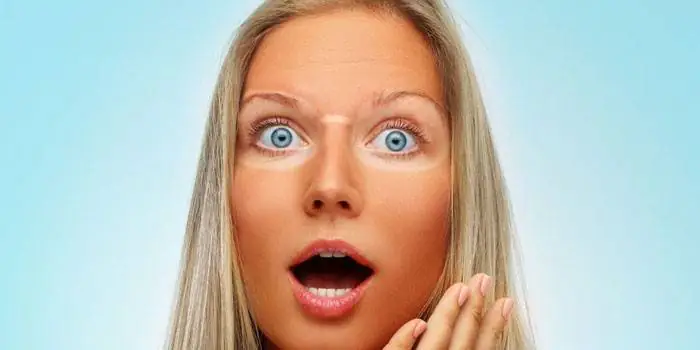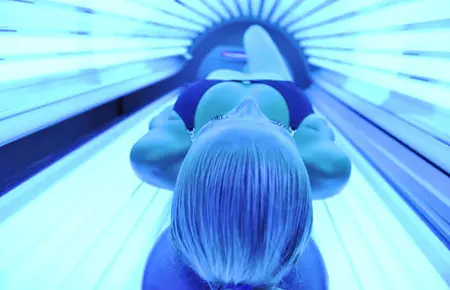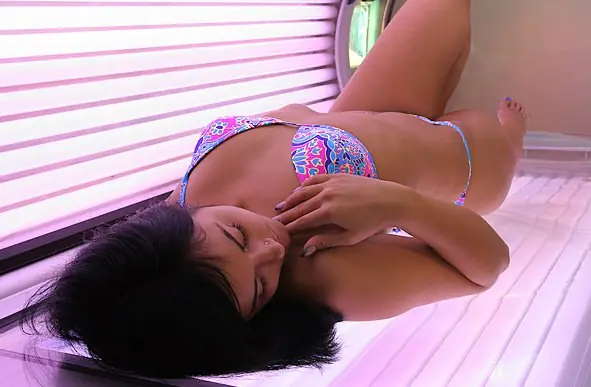A trip to a solarium involves excessive exposure of the skin to ultraviolet rays. Tanning enthusiasts cannot always stop in time, so they go for the procedure every day. This is strictly prohibited, because there is a threat of cancer development and exacerbation of chronic diseases.
How often can you sunbathe in a solarium?
Ultraviolet radiation is dangerous for humans if protection is not used. It penetrates deep into the epidermis, destroys cells, causes burns and neoplasms. To protect the skin, it produces melanin, which gives the skin a tan.
Doctors and cosmetologists believe that the break between procedures in a solarium should be 1-2 days. The first time you can sunbathe for no longer than a minute, subsequent times - 1.5-2 minutes. This is enough to get an even, beautiful shade and minimize the side effects of radiation. Useful tips for going to the solarium:
- Be sure to protect your body with special creams and your eyes with glasses;
- It is forbidden to remove underwear;
- after sunbathing, soothe the skin with cooling and nourishing lotions

Tanning in a solarium and skin type
The frequency of visiting a solarium directly depends on a person’s skin type, sensitivity and susceptibility to ultraviolet radiation. The mechanism of the procedure is simple - artificial ultraviolet light penetrates the skin and acts faster than the sun. But at the same time, the destructive power of the rays is many times greater.
If you do not follow the rules of tanning, you can seriously harm your health in a short time. If all precautions are taken, the tan will last a long time, give the body a beautiful shade, and hide imperfections. A course of 8-10 procedures is enough to maintain an even color.
Celtic type
This type of skin is pinkish or completely white, sometimes with freckles. A person does not tan even after several visits to the solarium. Therefore, it is better not to do this, but to use self-tanners.
European
This type is divided into light and dark. With the first, the skin is light, the hair is light brown, a tan appears immediately after a large dose of ultraviolet radiation. The first procedure should last up to 5 minutes, between the rest there are breaks of 1-2 days. Once the skin darkens, the session may increase to 10 minutes.
With a dark type, skin with an olive or yellowish undertone, hair is brown or light brown. You can sunbathe every other day for 3-5 minutes, the epidermis tolerates ultraviolet radiation well, and the tan goes on evenly.
Scandinavian
Very light, almost white skin without freckles. She does not tolerate tanning well, she instantly turns red and gets burned. Such people are not recommended to visit the solarium. If they do decide to do this, be sure to use sunscreen on their face and body.

Asiatic
Dark hair, dark skin, tan appears very easily, but due to the color of the epidermis it is not always visible. In the first session, you can spend 7 minutes, then increase the time of exposure to ultraviolet radiation to 10-15 minutes. The break between procedures will be 1-2 days.
Indonesian
The Indonesian type epidermis responds well to ultraviolet radiation, so for the first time you can stay in the solarium for up to 10 minutes. Every other day the procedure is repeated, lasting 15 minutes. After 6-7 sessions, the tan will appear clearly and will remain if you maintain it with weekly visits to the solarium.
African American
African-American people are dark-skinned and have black hair. There is no point in going to the solarium for them. Dark skin itself serves as protection from ultraviolet radiation, but this does not mean neglecting the use of special products.
Consequences of solarium abuse
If you visit a solarium every day and exceed the prescribed tanning time, the consequences can be dangerous. Abuse of ultraviolet radiation threatens the following reactions:
- Skin cancer - when cells begin to divide incorrectly, a malignant tumor occurs. It can spread to other organs and fluids (blood, lymph) and metastasize.
- Activation of the herpes virus - under the influence of the sun, the virus begins to multiply intensively, and if there are wounds or peeling on the skin, it will affect them and begin to form painful blisters.
- Aging - constant exposure to ultraviolet rays dries out the epidermis, disrupts the production of collagen and elastin, which leads to the appearance of wrinkles and pigmentation.
- Skin rash – occurs due to photosensitivity. Taking certain foods (citrus fruits, berries) or medications (antibiotics, painkillers) increases the skin's sensitivity to light, which gives such a negative reaction.

Contraindications
Doctors do not recommend visiting a solarium for people under 18 years of age. Other contraindications:
- pregnancy, lactation;
- the presence of melanoma, pigment spots, large convex moles;
- malignant cancer tumors;
- diabetes;
- skin diseases, exacerbation of chronic diseases;
- taking antibiotics, antidepressants, hormonal drugs, drugs to stabilize blood pressure;
- menstruation.
Video
Found an error in the text? Select it, press Ctrl + Enter and we will fix everything!
Since the solarium was invented, it has gained many fans. Ultraviolet helps get rid of depression, creates an even tan, treats psoriasis and some diseases of the musculoskeletal system. But the other side of the coin is also known. Ultraviolet radiation provokes the development of cancer cells. How often can you go to the solarium, and will daily procedures harm your health? Let's find out further.

Effect of ultraviolet
Solariums use ultraviolet radiation, which significantly affects biological tissue. Under natural conditions, the source of ultraviolet radiation is the sun. In the summer, to get a good tan, vacationers spend 2–3 hours on the beach almost every day. But we all know how badly those who do not know the limits get burned. People with fair skin, which become covered with red, inflamed spots, are especially affected. This suggests that you need to be able to sunbathe.
Ultraviolet waves are divided into several subtypes. For safety, solariums use lamps that produce only long-wave (UVA) and mid-wave (UVB) ultraviolet. These two types have the most gentle effect on the skin. And yet they influence us a hundred times more than the sun. This means that the time spent in the solarium should be strictly limited. In other words, you need to go there as little as possible.
The very first visit or visit after a long break should last no more than 3 minutes. After it, you will be able to evaluate how the skin reacts to the procedure.
It is necessary to take a break for 2-3 days to fully experience all the effects of visiting a solarium. If no negative symptoms appear, then continue to sunbathe, achieving a golden hue.
Remember that the International Agency for Cancer Research has listed tanning as a dangerous procedure. Intense ultraviolet radiation provokes the development of cancer cells. The procedure must be used with extreme caution.
Visiting hours
The time for the procedure should be chosen based on your skin phototype. There are 6 main phototypes:
- Celtic. White or slightly pinkish skin, possible freckles, blond, red hair. Such skin does not tan, so you should not torture it.
- Light-skinned European. Light skin and brown hair. You can go to the solarium once a week for 5 minutes. After acquiring a darker shade, the residence time can be increased to 10-12 minutes with visits every 2 days.
- Dark-skinned European. Skin with an olive, yellowish or light brown tint, chestnut, dark brown hair. It is possible to visit the solarium every other day, since the skin tolerates exposure to ultraviolet radiation well. The tan goes on evenly and lasts a long time.
- Mediterranean. Dark hair, dark skin. It is easiest for such people to tan. They can go to the solarium every other day, spending 15 minutes in it.
- Indonesian. Dark skin, black hair. The skin is not afraid of exposure to ultraviolet radiation, but is it necessary to sunbathe in a solarium in this case?
- African American. Dark brown skin, black hair. Such people do not need to go to the solarium; it is enough for them to sunbathe. And for good skin condition, it can be moisturized with special creams.
When you get the desired shade, you can only maintain it by visiting the solarium once a week. As you can see, it is not recommended for anyone to go for procedures every day.
Protective measures
Do not forget that there are contraindications to ultraviolet irradiation. If you have inflammatory processes on your skin, you should absolutely not visit a solarium. It will do more harm than good to those who have problems with the thyroid gland, are suspected of having cancer, and to those who have already been cured of these diseases.
It is not recommended for pregnant women to expose their body to ultraviolet radiation, since the reaction to radiation can be the most unexpected, ranging from the appearance of a large number of pigment spots to serious burns. Children under 15 years old should not sunbathe in a solarium either. They just need to spend more time outdoors, move, play sports.
Here are a few more contraindications to visiting a solarium that every person should know:
- the presence of a large number of moles;
- benign formations in the mammary glands;
- pigmentation disorder;
- taking photosensitizing drugs (some antibiotics, oral contraceptives, antipsychotics).
The stay time is selected based on your skin phototype. If you cannot determine it yourself, then consult a dermatologist. Tan gradually, setting the shortest period of time at first, and then increasing it.
Experts believe that it is enough to go to the solarium 50 times a year, spending no more than 10 minutes in it. This is just 1 visit per week.
Preparing for a visit to the solarium
Solarium treatments should be performed after removing makeup and other cosmetics. It's best to take a shower. This will help the skin retain more moisture during the tanning process and protect it from overheating and dryness. You can apply a special cream to the skin. It will provide additional protection and help you acquire a beautiful shade.
Particularly sensitive areas (eyes, lips, breast area) must be covered so as not to damage them. It is also recommended to wear a headscarf to avoid drying out your hair.
After the procedure, you need to apply a moisturizer or body lotion. It’s good if the cream contains vitamins A and E. You should refrain from taking a shower for the first few hours, especially a cold one.

There are a number of general recommendations for visiting a solarium, as well as individual ones - those that are suitable for certain categories of people.
The general rules for visiting a solarium are:
— a tanning course cannot consist of more than 8-10 sessions;
— the optimal time to stay in the solarium is 5-7 minutes;
— the break between sessions must be at least two days;
— after the course you should take a break for at least a month;
— You can visit the solarium no more than 50 times a year.
By following these recommendations, the likelihood of getting burns and other adverse effects from artificial tanning is minimized.
It is also important to take into account the individual type of appearance. Blondes with light eyes and pale skin should visit the solarium with extreme caution, as they are likely to get sunburned even with a minimum duration of the procedure. The first session in this case should not exceed three minutes. On each subsequent visit, the time spent in the solarium can be increased by one minute. However, the maximum allowed for blondes is only 7 minutes. You will have to stop at this figure, even if the tan goes on evenly and no visible negative changes are visible on the skin. 10 sessions is the maximum permissible norm for fair-skinned women.
Red-haired girls with fair skin are generally not recommended to sunbathe in a solarium, as they have a high risk of provoking the development of melanoma - skin cancer. If a woman with this type of appearance still decides to ignore this recommendation, she should be in the solarium with extreme caution and no more than three minutes per session.
Fair-skinned girls with light brown hair and dark eyes - owners of European skin type - can sunbathe in a solarium, observing only general rules. The likelihood of getting burns is minimal, and the tan, as a rule, goes on evenly and quickly.
Girls with dark skin can afford not to visit the solarium at all, since their body already looks “tanned.” However, if they want to become even darker, 5-7 sessions with a break of three days between them will be enough. The duration of stay in the solarium for owners of this skin type can be increased to 12 minutes.
There are categories of people for whom solariums are generally contraindicated. These include:
— people with a history of cancer;
- children under 16 years of age;
- persons registered with a dermatologist with skin diseases or rashes;
- people taking antibacterial drugs (at the end of the course of treatment, visiting the solarium is allowed).



